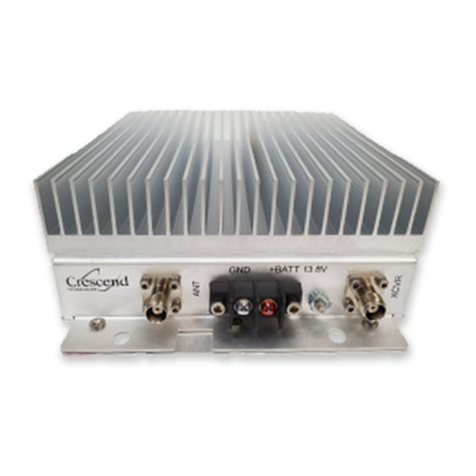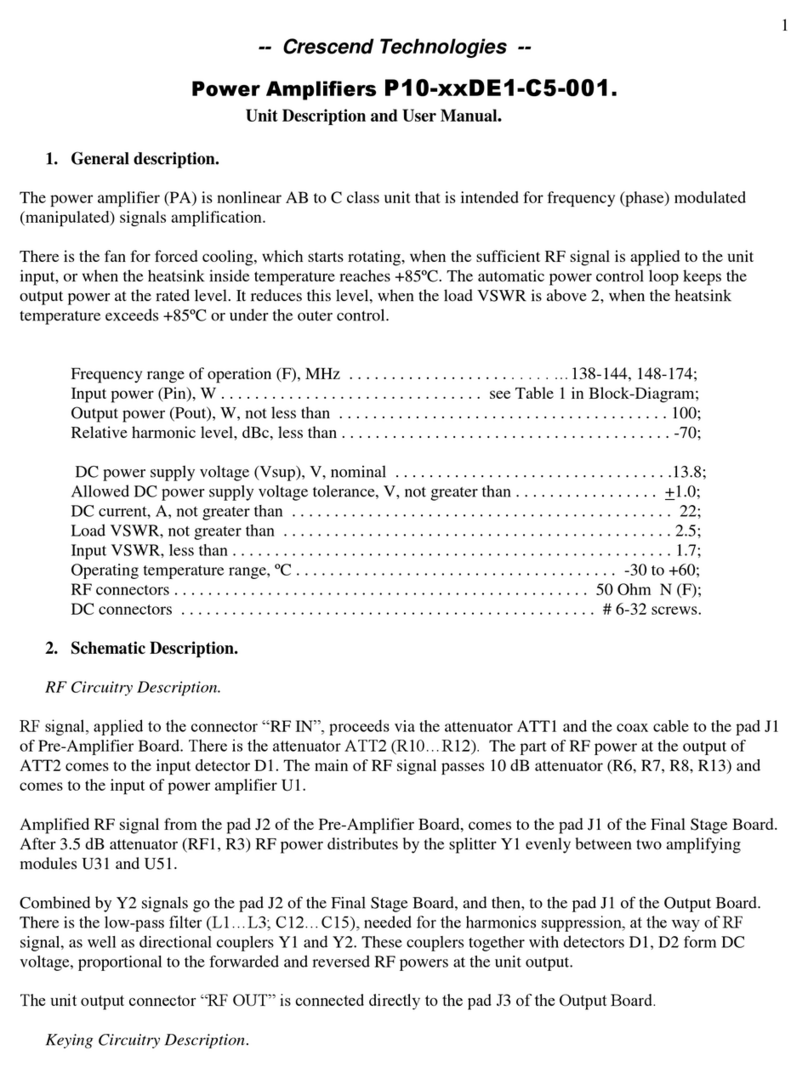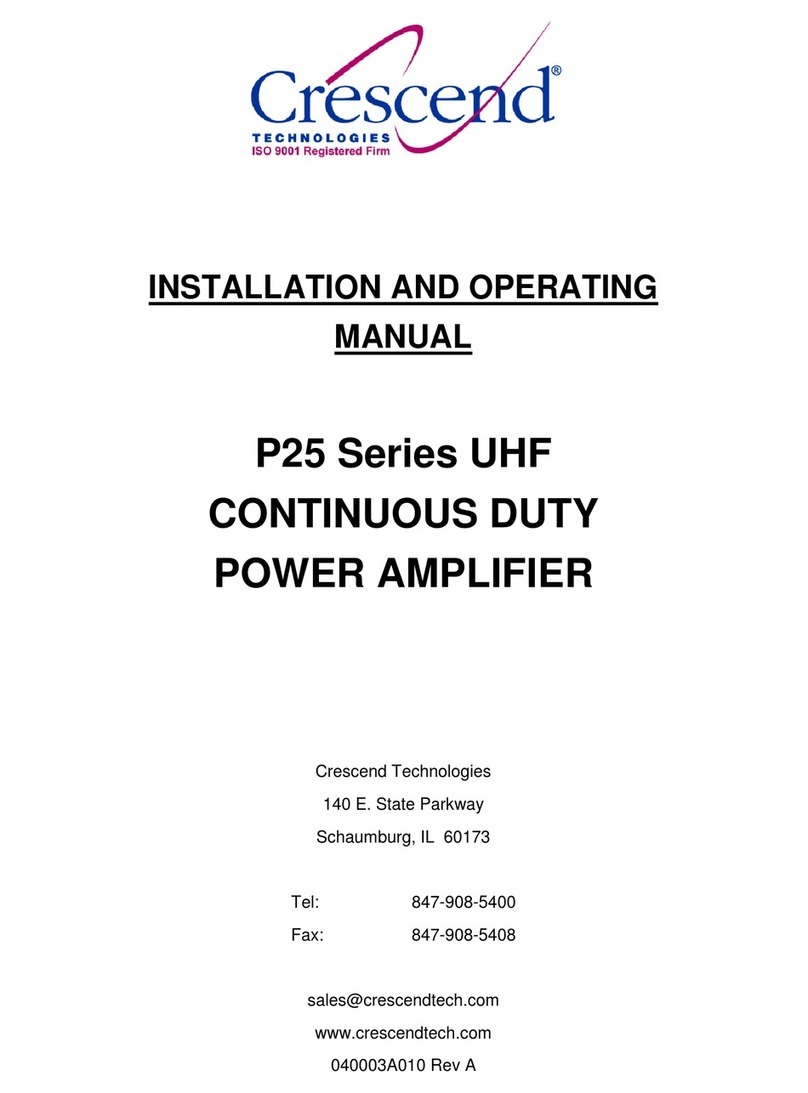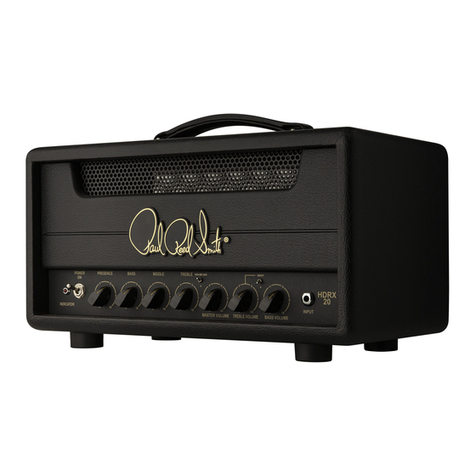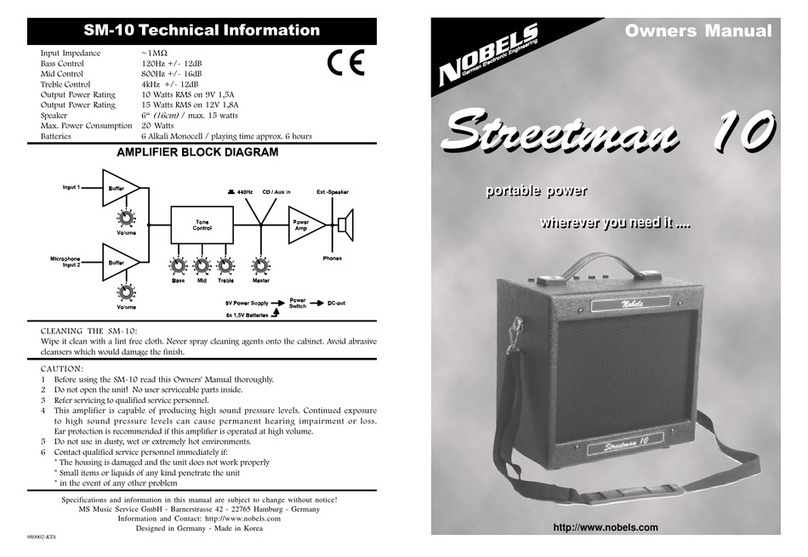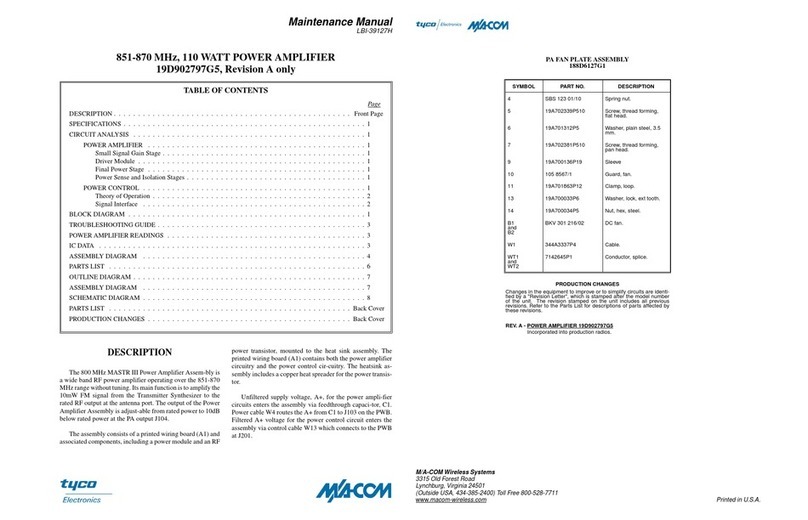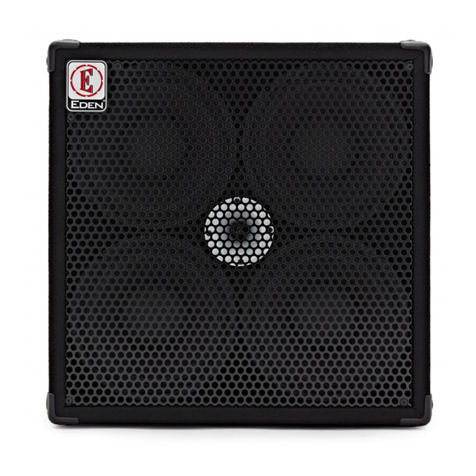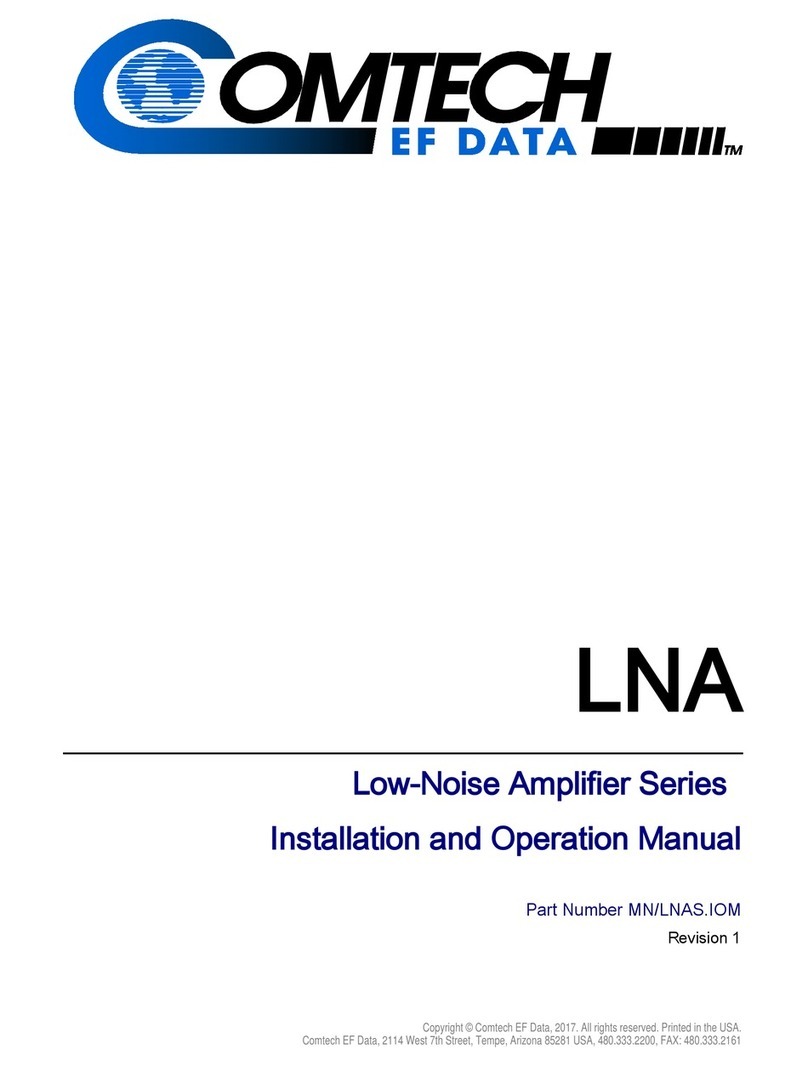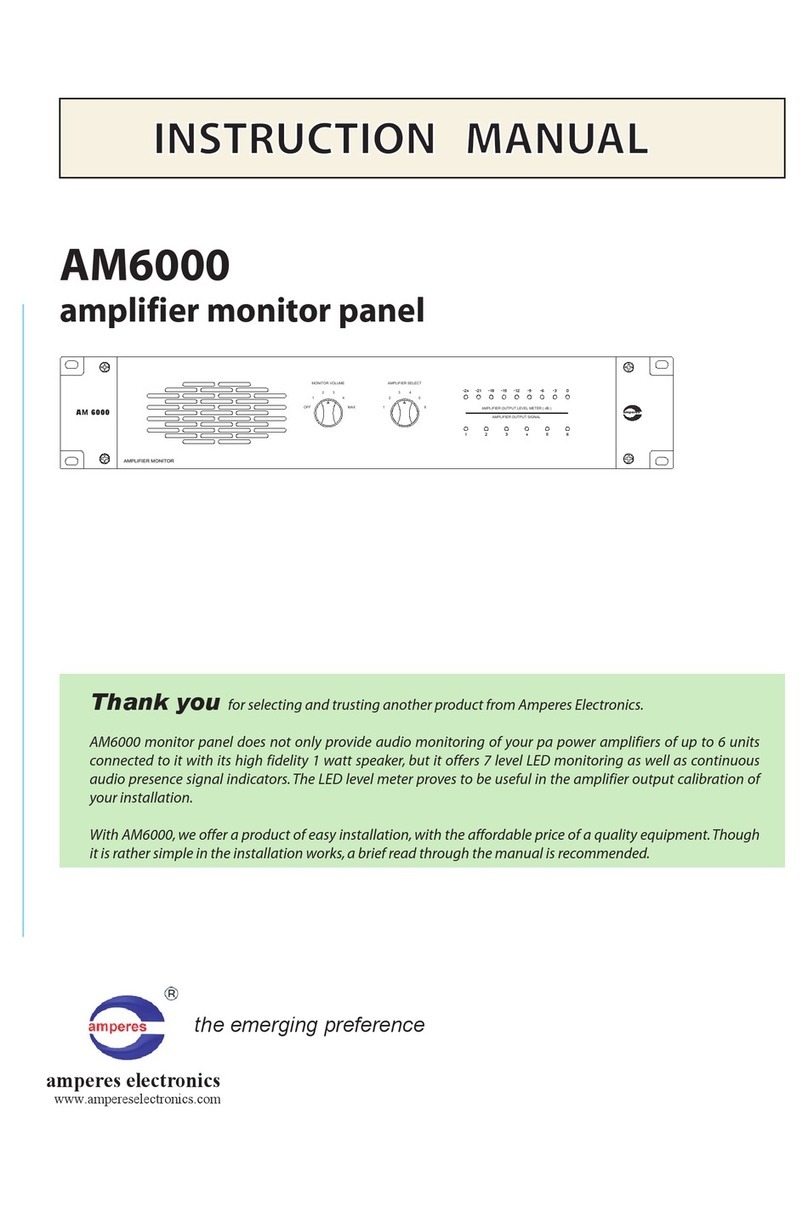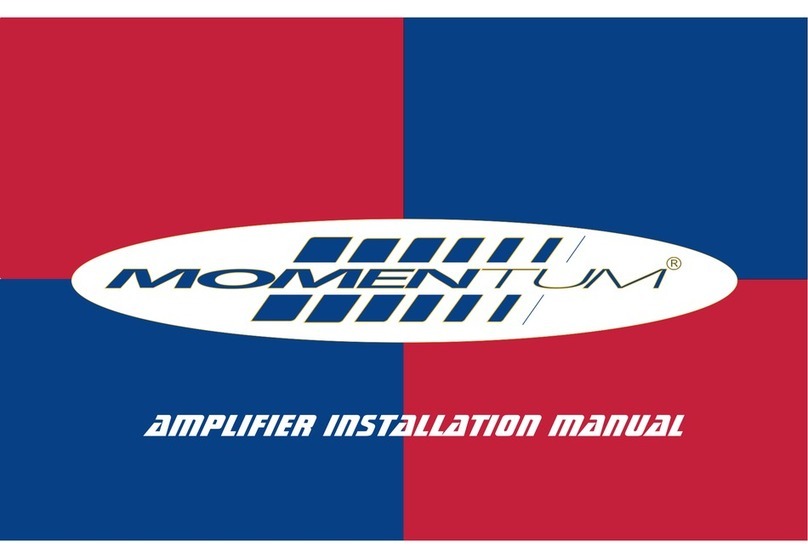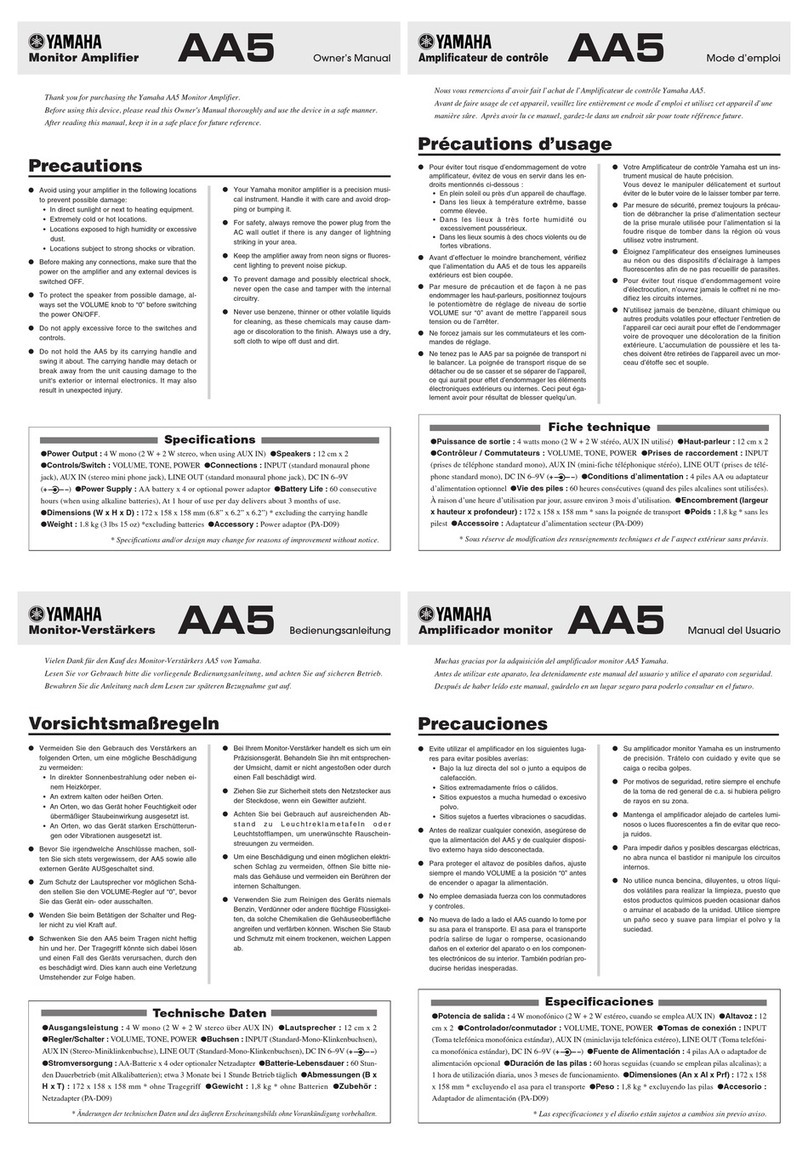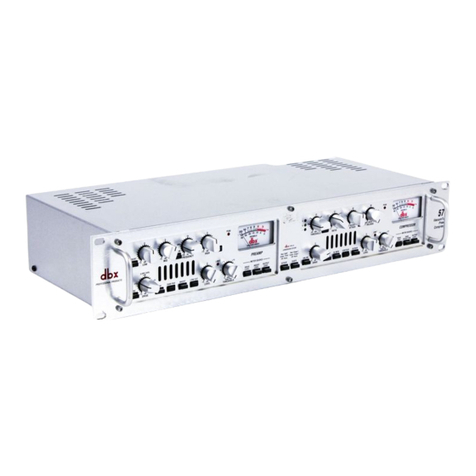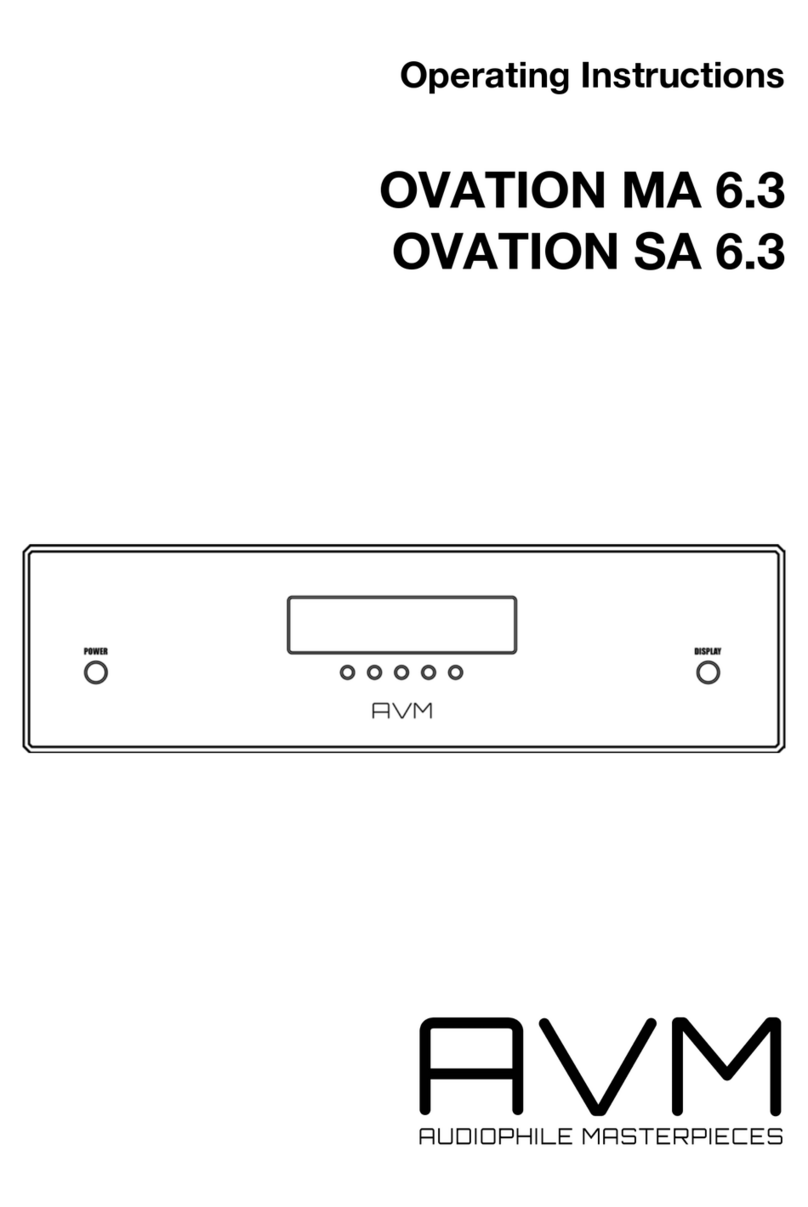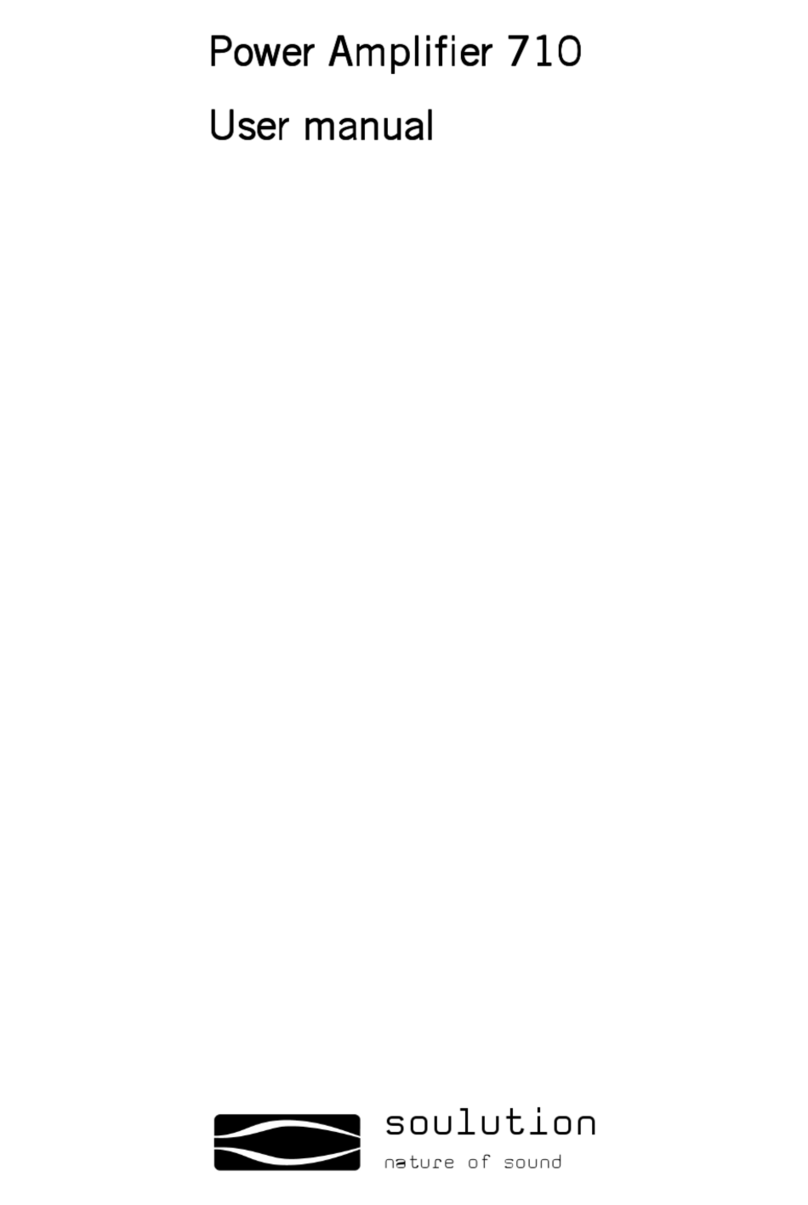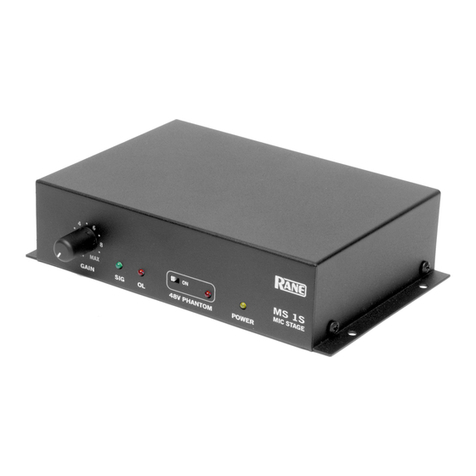Crescend C5 Series User manual

Copyright Crescend Technologies 040003A000 Rev C
INSTALLATION AND SERVICE
MANUAL
C5 SERIES
CONTINUOUS DUTY
POWER AMPLIFIER
August 20, 2008 Rev C
Crescend Technologies
920 E. State Parkway
Schaumburg, IL 60173
Tel: 847 908 5400
Fax: 847 908 5408
Web Site: www.CrescendTech.com

Copyright Crescend Technologies 2 040003A001 Rev C
TABLE OF CONTENTS
Section 1
Par. No. General Description Page No.
1.1 Introduction 4
1.2 General Description 4
1.3 Functional and Physical Specifications 5
1.4 Equipment Changes 5
Section 2
Installation
2.1 Introduction 8
2.2 Electrical Service Recommendations 8
2.3 Unpacking and Inspection 8
2.4 Installation Instructions 9
2.5 Amplifier Summary Alarm and Power Cutback Control 10
Section 3
General Operating Information
3.1 Introduction 11
3.2 Location of Status Indicators 11
3.3 Initial Start-Up 12
Section 4
Principles of Operation
4.1 Introduction 13
4.2 RF Input Signal 13
4.3 RF Output Load 13
4.4 Functional Description 13
4.4.1 Main RF Path 13
4.4.2 Loop Control 13
4.4.3 VSWR Protection 13
4.4.4 Thermal Protection 13
4.5 Amplifier Cooling 13

Copyright Crescend Technologies 3 040003A001 Rev C
TABLE OF CONTENTS (Continued)
Section 5
Par. No. Maintenance Page No.
5.1 Introduction 14
5.2 Periodic Maintenance 14
5.3 Cleaning Air Inlets/Outlets 14
5.4 Test Equipment Required for Test 15
5.5 Performance Test 15
Section 6
Troubleshooting
6.1 Introduction 16
6.2 Troubleshooting 16
6.3 Return for Service Procedure 17
6.3.1 Obtaining an RMA 17
6.3.2 Repackaging for Shipment 17
Figure List of Illustrations
1-1 C5 Series Amplifier, Front View 4
1-2 C5 Series Amplifier, Rear View 5
2-1 C5 Series Amplifier, Rear View Left 9
2-2 C5 Series Amplifier, Rear View Right 9
3-1 C5 Series Status Indicators, Front Panel 11
5-1 Amplifier Test Setup diagram 15
Table List of Tables
1-1 C5 Amplifier Functional Specifications 6
1-2 Frequency Ranges, Input/Output Power, Current,
Spurious and Harmonics 7
2-1 Summary Alarm and Cutback Control Connections 10
3-1 C5 Series Amplifier Status Indicators 11
5-1 Periodic Maintenance 14
5-2 Test Equipment Required 15
6-1 Troubleshooting 16

Copyright Crescend Technologies 4 040003A001 Rev C
1. GENERAL DESCRIPTION
1.1. INTRODUCTION
This manual contains information and procedures for installation, operation, and
maintenance of Crescend’s C5 Series Continuous Duty Power Amplifier. The manual is
organized into six sections as follows:
Section 1. General Description
Section 2. Installation
Section 3. Operating Instructions
Section 4. Principles of Operation
Section 5. Maintenance
Section 6. Troubleshooting
1.2. PRODUCT DESCRIPTION
The Crescend Technologies C5 Series of RF power amplifiers are designed for trunking
and conventional repeater applications. Rack mountable and designed to accept a range
of input powers for a given rated output power, each amplifier covers a broad range of
frequencies without retuning. Closed loop power control is used to maintain a constant
output power under varying voltage, signal input, frequency and output load conditions.
Several design features work to protect the amplifier under adverse conditions.
Designed to fit in 7 inches of rack space, the C5 front panel includes status LED indicators
for DC and Alarm conditions. RF Input, RF Output, DC, summary alarm and power
cutback connections are found on the back of the amplifier. A rear mounted fan brings in
air from the back and blows the air across the heat sink fins exiting out the sides of the
amplifier.
Figure 1-1. C5 Series Amplifier, Front View

Copyright Crescend Technologies 5 040003A001 Rev C
Figure 1-2. C5 Series Amplifier, Rear View
1.3. FUNCTIONAL AND PHYSICAL SPECIFICATIONS
Functional and physical specifications for the C5 Series amplifiers are listed in Tables 1-1
and 1-2.
1.4. EQUIPMENT CHANGES
Crescend Technologies, Inc. reserves the right to make minor changes without notice,
including, but not necessarily limited to, component substitution and circuitry changes.
Such changes may or may not be incorporated in this manual, although it is our intention to
keep each manual as up-to-date as possible. To that end, we ask that you, our customer,
share information with us acquired in field situations, which might be of assistance to
another user.

Copyright Crescend Technologies 6 040003A001 Rev C
Table 1-1. C5 Series Amplifier Functional Specifications
Frequency Range: See Table 1-2 (Range Set at Factory)
Operating Voltage: +13.8 ±0.7 Vdc
Current Consumption: See Table 1-2
Duty Cycle: 100%
Power Input: See Table 1-2 (Range Set at Factory)
Power Output (Single Carrier Operation): See Table 1-2 (Range Set at Factory)
Intermodulation: >10 dB
Spurious & Harmonics: See Table 1-2
Input/Output Impedance: 50 Ohms (Nominal)
Load VSWR Tolerance: VSWR Protected above 2.5:1 (Nominal)
Input/Output Connector: Type N Female
Vertical Mounting: 7.0 in
Horizontal Mounting: 19.0 in
Depth: 6.0 in
Weight: 10 lbs (4.6 kg) (Nominal)
Cooling Method: Fan Forced Air Over Heat Sink
Operating Temp. Range: -30°C to +60 °C
Storage & Transport: -40 °C to +70 °C
Humidity: 80% at +40 °C (Non-Condensing)
Altitude: 10,000 Feet (Maximum)
Front Panel Display: INDICATORS
DC ON (Green), LOW OUTPUT (Red),
HIGH VSWR (Red), OVER TEMP (Red)
Alarm and Control Pins:
SUMMARY ALARM
Summary of Low Output, High VSWR, Over
Temp Alarms
CONTROLS
CTRL(Partial Power Cutback)
SH/D (External Power Control)

Copyright Crescend Technologies 7 040003A001 Rev C
Table 1-2. Frequency Ranges, Input/Output Power, Current, Spurious and Harmonics
Frequency
Range (MHz) Input Power
Range (W) Rated Output
Power (W)
Typ
Current
(A)
Max
Current
(A)
Spurious and
Harmonics
(dBc)
30-36 (AA)
36-42 (AB)
42-50 (AC)
2-5
5-10
10-20
20-50
100 (P10) 20 23 <-65
136-144 (DA)
144-152 (DB)
152-162 (EA)
162-174 (EB)
360-400 (UX L)
0.1-0.2
0.2-0.5
0.5-1
1-2
2-5
5-10
10-20
20-50
80 (P8)
100 (P10)
110 (P11)
150 (P15)
16
18
22
26
19
23
25
28
<-65
<-65
<-65
<-67
406-426 (GA)
426-450 (GB)
450-470 (HA)
470-490 (HB)
490-512 (HC)
0.1-0.2
0.2-0.5
0.5-1
1-2
2-5
5-10
10-20
20-50
159 (P10) 22 26 <-65
764-776 (J)
0.1-0.2
0.2-0.5
0.5-1
1-2
2-5
5-10
10-20
20-50
80 (P8) 20 24 <-63
850-870 (K)
0.1-0.2
0.2-0.5
0.5-1
1-2
2-5
5-10
10-20
20-50
80 (P9) 19 23 <-63
928-942 (L)
0.1-0.2
0.2-0.5
0.5-1
1-2
2-5
5-10
10-20
20-50
75 (P9) 19 23 <-63
NOTES: Manufacturer’s Rated Output Power of this Equipment is for Single Carrier
Operation.
All specifications above apply at +13.8 ± 0.1 VDC operating voltage,
ambient temperature of 25°C ± 5°C.

Copyright Crescend Technologies 8 040003A001 Rev C
2. INSTALLATION
2.1. INTRODUCTION
This section contains installation recommendations, unpacking, inspection, and installation
instructions for the C5 Series of amplifiers. Carefully read all the material in this section
prior to equipment unpacking or installation. Also read and review the operating procedures
in Section 3 prior to installing the equipment. It is important that the licensee perform these
tasks correctly and in good faith. If applicable, carefully read Parts 73 and 74 of the Federal
Communications Commission (FCC) rules to determine how they apply to your installation.
DON’T TAKE CHANCES WITH YOUR LICENSE.
2.2. ELECTRICAL SERVICE RECOMMENDATIONS
Crescend Technologies recommends that proper AC line conditioning and surge
suppression be provided on the primary AC input to the +13.8 VDC power source. All
electrical service should be installed in accordance with the National Electrical Code, any
applicable state or local codes, and good engineering practice. Special consideration
should be given to lightning protection of all systems in view of the vulnerability of most
transmitter sites to lightning. Lightning arrestors are recommended in the service entrance.
Straight, short ground runs are recommended. The electrical service must be well
grounded. Each amplifier should have its own circuit breaker.
2.3. UNPACKING AND INSPECTION
This equipment has been operated, tested and calibrated at the factory. Only in the event
of severe shocks or other mistreatment should any substantial readjustment be required.
Carefully open the container(s) and remove the amplifier module(s). Retain all packing
material that can be reassembled in the event that the unit must be returned to the factory.
CAUTION: Exercise care in handling equipment during inspection to
prevent damage caused by rough or careless handling.
Visually inspect the amplifier module for damage that may have occurred during shipment.
Check for evidence of water damage, bent or warped chassis, loose screws or nuts, or
extraneous packing material in the connector or fans. Inspect the rear panel connector for
bent connector pins. If the equipment is damaged, a claim should be filed with the carrier
once the extent of any damage is assessed. We cannot stress too strongly the importance
of IMMEDIATE careful inspection of the equipment and the subsequent IMMEDIATE filing
of the necessary claims against the carrier if necessary. If possible, inspect the equipment
in the presence of the delivery person. If the equipment is damaged, the carrier is your first
area of recourse. If the equipment is damaged and must be returned to the factory, write or
phone for a return authorization. Crescend may not accept returns without a return
authorization. Claims for loss or damage may not be withheld from any payment to
Crescend, nor may any payment due be withheld pending the outcome thereof. WE
CANNOT GUARANTEE THE FREIGHT CARRIER’S PERFORMANCE.

Copyright Crescend Technologies 9 040003A001 Rev C
2.4. INSTALLATION INSTRUCTIONS
The C5 amplifier is designed for installation in a rack that permits access to the rear of the
rack for connection of DC power, RF, and monitor/control cables. The amplifier must have a
minimum of 3 inches of open space behind the rear fan to allow adequate ventilation.
To install the amplifier proceed as follows:
1. Install amplifier in equipment rack and secure in place.
2. Connect a 50 ohm antenna cable and load to the RF OUT connector on rear of
amplifier.
3. Connect the transceiver/exciter output to RF IN connector on rear of amplifier.
4. If monitoring of PA is desired, connect alarm cable to “ALARM” pin on rear of
amplifier module. See section 2.5 for more details.
5. If limited output power control of PA is desired, connect control cable or
appropriate resistor to “SH/D” pin on rear of amplifier module. See section 2.5 for
more details.
6. If remote output power cutback of PA is desired, connect control cable to “CTRL”
pin on rear of amplifier module. See section 2.5 for more details.
7. Measure primary DC input voltage. DC input voltage should be +13.8 +/- 0.1VDC.
Turn off DC voltage.
WARNING: Turn off external primary DC power before connecting DC power cables.
8. Connect positive primary power wire (+13.8VDC) to terminal marked +13.8VDC
and negative primary power wire to GND terminal on rear of amplifier.
9. Check your work before applying DC voltage to the system. Make certain all
connections are tight and the DC wires are going to the correct terminals.
10. Refer to Section 3 for initial start-up procedures.
NOTE:
1. Make sure power supply DC is well filtered and well behaved with minimal
voltage overshoot.
2. Keep DC wires as short as possible to minimize inductance induced voltage
transients.
3. Size DC Wires properly to handle the load current to minimize voltage drop.
Figure 2-1. C5 Series Amplifier, Rear View Left

Copyright Crescend Technologies 10 040003A001 Rev C
Figure 2-2. C5 Series Amplifier, Rear View Right
2.5. AMPLIFIER SUMMARY ALARM AND POWER CUTBACK CONTROL
The summary alarm and cutback control connections are made through separate filtered
feedthrough connectors on the back of the amplifier.
Table 2-1. Summary Alarm and Cutback Control Connections
PIN FUNCTION DESCRIPTION CONDITION APPROPRIATE
LOAD
Alarm: < 1 VDC
Normal Operation: > 8 VDC
(up to Vcc)
> 10 kOhm,
< 100pF
ALARM Summary
Alarm
Indicates when:
1. The output power is low,
or
2. VSWR cutback is
activated, or
3. Thermal cutback is
activated
Alarm: < 1 VDC
Normal Operation: 4 - 5
VDC
1.8 kOhm
between pin and
ground,
<500 pF
(TTL
compatible)
Normal Operation – pin not
connected.
CTRL Partial
Power
Cutback
Used as a simple means of
cutting back output power
by a fixed amount (1-1.5
dB). Cutback Mode – pin pulled
to ground. The output
power reduces by
approximately 1dB-1.5 dB.
<10 Ohm,
< 100pF
Normal Operation – pin not
connected.
SH/D External
Power
Control
It is possible to reduce the
output power continuously
by up to 4 dB by connecting
a resistor between this pin
and ground. Power Control Mode – pin
pulled to ground through
resistor.
Resistor value
0-50 kOhm,
<100 pF

Copyright Crescend Technologies 11 040003A001 Rev C
3. GENERAL OPERATING INFORMATION
3.1. INTRODUCTION
This section contains operating instructions for the C5 amplifier.
3.2. LOCATION OF STATUS INDICATORS
The location and function of the C5 amplifier status indicators and is shown in Figure 3-1
and described in detail in Table 3-1.
Figure 3-1. C5 Series Status Indicators, Front Panel
Table 3-1. C5 Series Amplifier Status Indicators
STATUS LED FUNCTION
DC ON
Green LED. Illumination indicates DC Power has been applied.
LOW OUTPUT
Red LED. Activates when the output power drops to approximately
80-85% of set output power.
HIGH VSWR
Red LED. Activates when load VSWR exceeds approximately
2.5:1.
HIGH TEMP
Red LED. Activates when the amplifier exceeds a safe operating
temperature.

Copyright Crescend Technologies 12 040003A001 Rev C
3.3. INITIAL STARTUP
To perform the initial start-up, proceed as follows:
Check to ensure that all input and output cables are properly connected and tightened.
Note: Use high quality coaxial cable and connectors. Properly install and solder all
connectors for reliability.
CAUTION: Before applying power, make sure that the input and output of the
amplifier are properly terminated in 50 ohms. Do not operate the
amplifier without a load attached. Refer to Table 1-2 for input
power requirements. Excessive input power will damage the
amplifier.
NOTE:
The output coaxial cable between the amplifier and the antenna
must be 50 ohm coaxial cable.
2. Apply DC power to the amplifier. Verify that the power supply measures 13.8 ± 0.1VDC.
The fan will come on immediately for a few seconds and then turn off.
3.Visually check the indicators on each amplifier module, and verify the following:
a. The DC PWR ON indicator (green) should be on.
b. All ALARM LED indicators (red) should be off.
4.Turn on external exciter/transceiver and apply RF input signal. The fan should turn on
after approximately 3 seconds.
5.Turn off RF input signal. The fan should continue running, but turn off after
approximately 6-8 seconds.

Copyright Crescend Technologies 13 040003A001 Rev C
4. PRINCIPLES OF OPERATION
4.1. INTRODUCTION
This section contains principles of operation of the C5 Series of RF Power Amplifiers.
4.2. RF INPUT SIGNAL
The amplifiers are set at the factory to work over different input power ranges. The
available range of inputs for different frequency ranges may be found in Table 1-2.
4.3. RF OUTPUT LOAD
The load impedance should be as good as possible (VSWR <1.2:1) in the working band for
good power transfer to the load and maximum amplifier efficiency.
4.4. FUNCTIONAL DESCRIPTION
The amplifier is a single channel CW amplifier that operates in various frequency bands
from 30 MHz to 942 MHz. The amplifier specifications are listed in Tables 1-1 and 1-2.
4.4.1. MAIN RF PATH
The typical main RF path consists of an input attenuator, driver, splitter, final stage(s),
combiner, rf detectors and harmonic filter. The circuitry becomes active upon the
sensing of rf input power. This occurs when rf input reaches approximately 3 dB below
the low end of the input power range. This keeps standby current at a minimum (< 20
mA) when rf input is not present (or is below the turn on level).
4.4.2. LOOP CONTROL
The loop control circuitry includes circuitry to works to maintain a constant output power
versus variations in DC voltage, rf input power, frequency and load. A coupled detector
at the output monitors the final RF output level and generates a DC voltage proportional
to the RF output level. This voltage is fed back to the controller. The circuitry compares
this voltage to a reference voltage and varies the gain of the amplifier to maintain a
constant output.
4.4.3. VSWR PROTECTION
Reflected power is detected at the output of the amplifier and compared to forward
power. When reflected power reaches an equivalent VSWR of approximately 2.5:1, the
amplifier output is reduced to protect the finals and the front panel HIGH VSWR LED
activates. The higher the load VSWR, the more the output power is reduced.
4.4.4. THERMAL PROTECTION
The heat sink temperature is monitored with a thermostat. When the heat sink
temperature reaches an unsafe level, the output power of the amplifier is reduced by
approximately 50%. This keeps the channel on the air while still providing some short
term protection until the customer can address the underlying cooling issue.
4.5. AMPLIFIER COOLING
The amplifier is cooled with forced air over a large heat sink. The fan, located on the rear of
the amplifier and switched on and off with rf input power (3 seconds delay from detection of
RF and 6 seconds hang after RF is removed), draws ambient air in from the back of the
amplifier and forces it over the heat sink. The rear baffle forces the air to run over the fins
and exit on each side of the amplifier. It is important to keep a minimum clearance of 3
inches behind the fan and allow the coolest air possible to circulate through the fan.

Copyright Crescend Technologies 14 040003A001 Rev C
5. MAINTENANCE
5.1. INTRODUCTION
This section contains periodic maintenance and performance test information for the C5
Series. It also contains a list of test equipment required to perform various tests.
NOTE:
Check your sales order and equipment warranty before attempting to service
or repair the unit. Do not break the seals on equipment under warranty or the
warranty will be null and void. Do not return equipment for warranty or repair
service until proper shipping instructions are received from the factory.
5.2. PERIODIC MAINTENANCE
Periodic maintenance requirements are listed in Table 5-1. Table 5-1 also lists the intervals
at which the tasks should be performed.
WARNING: Wear proper eye protection to avoid eye injury when using
compressed air.
Table 5-1. Periodic Maintenance
TASK INTERVAL ACTION
Clean Air Vents/Check
Fan 30 Days Inspect and clean per paragraph 5-3.
Verify fan is working properly.
Inspect Cables and
Connectors and General
Site Conditions
6 Months Inspect signal and power cables for
frayed insulation and proper attachment.
Check RF connectors to make sure that
they are tight. Inspect the lightning
protection system and ground at the site.
5.3. CLEANING AIR INLETS/OUTLETS
The air inlets and outlets should be checked every 30 days and cleaned if necessary. If the
equipment is operated in a severe dust environment, it should be checked and cleaned
more often. If dust and dirt are allowed to accumulate, the cooling efficiency will be
diminished. Using either compressed air or a brush with soft bristles, loosen and remove
accumulated dust and dirt from the air inlet panels.
Check that the fan is running smoothly. A slow running or noisy fan may indicate an
imminent fan failure. Replace immediately with a similar to insure long term reliability.
Heat is one of the biggest factors in reducing the reliability of your amplifier. Make sure the
fan has access to cool and clean airflow within the rack.

Copyright Crescend Technologies 15 040003A001 Rev C
5.4. TEST EQUIPMENT REQUIRED FOR TEST
Test equipment required to test the amplifier performance is listed in Table 5-2. Equivalent
test equipment may be substituted for any item.
NOTE: All RF test equipment must be calibrated to 0.05 dB resolution. Any deviation
from the nominal attenuation must be accounted for and factored into all
output readings.
Table 5-2. Test Equipment Required (or equivalent)
EQUIPMENT MANUFACTURER MODEL
Signal Generator (1) H.P. 8657B
30 dB Attenuator, 200 Watt (1) Tenuline 8322
DC power supply (1) H.P 6673A
Spectrum Analyzer (1) H.P. 8560E
Power Meter (1) HP E4418A
Power Meter (1) HP E4419A
Power Sensor (3) HP 8481A
Pad (3) Mini-Circuits NAT-20
Coupler (2) Narda 3020A
Coupler Load (1)
Lab Amplifier (1) AR 30W1000M7
5.5. PERFORMANCE TEST
Performance testing may be conducted to ensure that the amplifier system meets the
operational specifications listed in Tables 1-2 and 1-3. The test equipment required to
perform the testing is listed in Table 5-2 and the test setup is shown in Figure 5-1.
Figure 5-1. Amplifier Test Setup Diagram
Signal
Generator Lab
Amplifier Coupler
UUT Coupler Attenuator
30 dB Spectrum
Analyzer
Power
Supply
20
dB 20
dB 20
dB
Watt Meter
Watt Meter
Lo
ad
S
e
n
s
e
S
e
n
s
e
S
e
n
s
e

Copyright Crescend Technologies 16 040003A001 Rev C
6. TROUBLESHOOTING
6.1. INTRODUCTION
This section contains a list of potential problems and suggested actions to be taken. If the
suggested corrective action does not eliminate the problem, please contact your Crescend
factory for further instructions.
NOTE: Check your sales order and equipment warranty before attempting to
service or repair the unit. Do not break the seals on equipment under warranty
or the warranty will be null and void. Do not return equipment for warranty or
repair service until proper shipping instructions are received from the factory.
6.2. TROUBLESHOOTING
Refer to Table 6-1 for troubleshooting suggestions. It has been found that in some cases it
may be necessary to power cycle an amplifier (turn DC power off and back on without RF
applied) to clear an alarm. Table 6-1. Troubleshooting
INDICATOR LED STATUS OUTPUT POWER STATUS POSSIBLE CAUSE SUGGESTED ACTIONS
Unlit No power No voltage at unit 1. Check power supply voltageDC PWR ON
(Green) On Set power Normal operation 1. No action required
Frequency is out of
range 1. Check frequency
The input power is
below the low end of
the rated input range
1. Check input power
Power supply voltage
is too low 1. Check power supply voltage
at amplifier DC connector
during key-up
On (all other
alarm LEDs
off)
Problem inside
amplifier 1. Send the unit back to factory
LOW
OUTPUT
(Red)
On (together
with HIGH
VSWR alarm
LED)
Less than set power
Output load VSWR is
much above 2.5:1 1. Turn off amplifier (or remove
RF input)
2. Check output connections
and cables for integrity and
tightness
3. Check antenna, combiner,
etc. for proper return loss
HIGH VSWR
(Red) On Less than set power Output load VSWR is
above 2.5:1 1. Turn off amplifier (or remove
RF input)
2. Check output connections
and cables for integrity and
tightness
3. Check antenna, combiner,
etc. for proper return loss
Fan is not rotating 1. Check if +13 VDC is present
on the FAN feedthrough pin
when rf input present (after
3 sec turn on delay)
2. Check if anything is
physically stopping rotation
3. If fan has failed, replace fan
with same or similar fan
Power supply voltage
is too low causing
insufficient air flow
1. Check power supply voltage
OVER TEMP
(Red) On Less than set power
Operating
temperature of
amplifier is exceeding
safe level. Note:
When unit cools, LED
turns off and output
returns to rated power
2. Make sure that air access to
front and rear of unit is
unimpeded
3. Verify that air vents are
clear of dust and dirt and
that fan(s) are operating
properly. Replace fan if
necessary
4. Check ambient temperature
(not to exceed spec - see
Table 1-2)

Copyright Crescend Technologies 17 040003A001 Rev C
6.3. RETURN FOR SERVICE PROCEDURES
When returning products to Crescend, the following procedures will ensure optimum
response.
6.3.1. OBTAINING AN RMA
A Return Material Authorization (RMA) number must be obtained prior to returning
equipment to the factory for service. Please contact our Customer Service Department
at 800-872-6233 to obtain this number. Failure to obtain this RMA number may result in
considerable delays in receiving repair service.
6.3.2. REPACKAGING FOR SHIPMENT
To ensure safe shipment of the amplifier, it is recommended to use the packaging
designed for the amplifier. The original packaging material is reusable. If it is not
available, contact Crescend’s Customer Service Department for packing materials and
information.
Table of contents
Other Crescend Amplifier manuals
